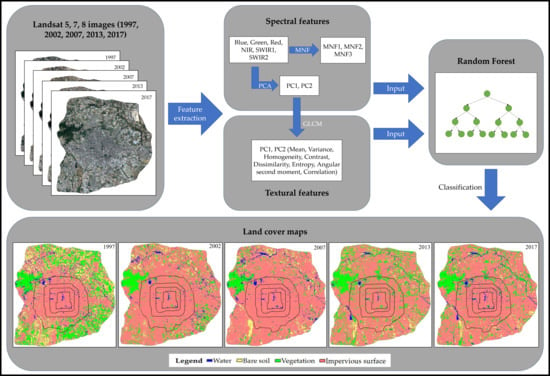Monitoring Spatiotemporal Changes of Impervious Surfaces in Beijing City Using Random Forest Algorithm and Textural Features
Abstract
1. Introduction
2. Study Area and Datasets
2.1. Study Area
2.2. Datasets
3. Methods
3.1. Auxiliary Features Extraction
3.2. Textural Features Extraction
3.3. The Random Forest Algorithm
3.4. Classification Strategy
4. Results and Analyses
4.1. Effect of Textural Features on Classification Accuracy
4.2. Impervious Surface Changes
4.2.1. Spatial Changes
4.2.2. Temporal Changes
4.2.3. Regional Changes
5. Discussion
5.1. Driving Factors of the Impervious Surface Changes
5.2. Regional Urbanization Level and Process
5.3. Limitations and Future Work
6. Conclusions
Author Contributions
Funding
Data Availability Statement
Acknowledgments
Conflicts of Interest
References
- United Nations, Department of Economic and Social Affairs, Population Division. World Urbanization Prospects: The 2014 Revision Highlights, (ST/ESA/SER.A/352); UN: New York, NY, USA, 2014. [Google Scholar]
- Arnold, C.L.; Gibbons, C.J. Impervious surface coverage: The emergence of a key environmental indicator. J. Am. Plan. Assoc. 1996, 62, 243–258. [Google Scholar] [CrossRef]
- Yuan, F.; Bauer, M.E. Comparison of impervious surface area and normalized difference vegetation index as indicators of surface urban heat island effects in Landsat imagery. Remote Sens. Environ. 2007, 106, 375–386. [Google Scholar] [CrossRef]
- Dams, J.; Dujardin, J.; Reggers, R.; Bashir, I.; Canters, F.; Batelaan, O. Mapping impervious surface change from remote sensing for hydrological modeling. J. Hydrol. 2013, 485, 84–95. [Google Scholar] [CrossRef]
- Lu, D.S.; Li, G.Y.; Kuang, W.H.; Moran, E. Methods to extract impervious surface areas from satellite images. Int. J. Digit. Earth 2014, 7, 93–112. [Google Scholar] [CrossRef]
- Pappas, E.A.; Smith, D.R.; Huang, C.; Shuster, W.D.; Bonta, J.V. Impervious surface impacts to runoff and sediment discharge under laboratory rainfall simulation. Catena 2008, 72, 146–152. [Google Scholar] [CrossRef]
- Ridd, M.K. Exploring a V-I-S (vegetation-impervious surface-soil) model for urban ecosystem analysis through remote sensing: Comparative anatomy for cities. Int. J. Remote Sens. 1995, 16, 2165–2185. [Google Scholar] [CrossRef]
- Madhavan, B.B.; Kubo, S.; Kurisaki, N.; Sivakumar, T.V.L.N. Appraising the anatomy and spatial growth of the Bangkok Metropolitan area using a vegetation-impervious-soil model through remote sensing. Int. J. Remote Sens. 2001, 22, 789–806. [Google Scholar] [CrossRef]
- Wu, C.S.; Murray, A.T. Estimating impervious surface distribution by spectral mixture analysis. Remote Sens. Environ. 2003, 84, 493–505. [Google Scholar] [CrossRef]
- Xu, H.Q. A new remote sensing index for fastly extracting impervious surface information. Geomat. Inf. Sci. Wuhan Univ. 2008, 33, 1150–1154. [Google Scholar]
- Shao, Z.; Fu, H.; Fu, P.; Yin, L. Mapping urban impervious surface by fusing optical and SAR data at the decision level. Remote Sens. 2016, 8, 945. [Google Scholar] [CrossRef]
- Zhang, Y.Z.; Zhang, H.S.; Lin, H. Improving the impervious surface estimation with combined use of optical and SAR remote sensing images. Remote Sens. Environ. 2014, 141, 155–167. [Google Scholar] [CrossRef]
- Breiman, L. Random forests. Mach. Learn. 2001, 45, 5–32. [Google Scholar] [CrossRef]
- Rodriguez-Galiano, V.F.; Ghimire, B.; Rogan, J.; Chica-Olmo, M.; Rigol-Sanchez, J.P. An assessment of the effectiveness of a random forest classifier for land-cover classification. ISPRS J. Photogramm. 2012, 67, 93–104. [Google Scholar] [CrossRef]
- Gislason, P.O.; Benediktsson, J.A.; Sveinsson, J.R. Random Forests for land cover classification. Pattern Recognit. Lett. 2006, 27, 294–300. [Google Scholar] [CrossRef]
- Fawagreh, K.; Gaber, M.M.; Elyan, E. Random Forests: From Early Developments to Recent Advancements. Syst. Sci. Control Eng. 2014, 2, 602–609. [Google Scholar] [CrossRef]
- Rokach, L. Ensemble-based classifiers. Artif. Intell. Rev. 2010, 33, 1–39. [Google Scholar] [CrossRef]
- Kottek, M.; Grieser, J.; Beck, C.; Rudolf, B.; Rubel, F. World map of the Köppen-Geiger climate classification updated. Meteorol. Z. 2006, 15, 259–263. [Google Scholar] [CrossRef]
- Zhang, C.L.; Chen, F.; Miao, S.G.; Li, Q.C.; Xia, X.A.; Xuan, C.Y. Impacts of urban expansion and future green planting on summer precipitation in the Beijing metropolitan area. J. Geophys. Res. 2009, 114, D02116. [Google Scholar] [CrossRef]
- Lin, X.C.; Yu, S.Q. Interdecadal changes of temperature in the Beijing region and its heat island effect. Chin. J. Geophys. 2005, 48, 39–45. [Google Scholar] [CrossRef]
- Zhang, L.; Gao, S.; Wei, B.; Li, Y.; Li, H.; Wang, L.; Ye, B. Effects of urbanization on rural drinking water quality in Beijing, China. Sustainability 2017, 9, 461. [Google Scholar] [CrossRef]
- Rodriguez-Galiano, V.F.; Chica-Olmo, M.; Abarca-Hernández, F.; Atkinson, P.M.; Jeganathan, C. Random Forest classification of Mediterranean land cover using multi-seasonal imagery and multi-seasonal texture. Remote Sens. Environ. 2012, 121, 93–107. [Google Scholar] [CrossRef]
- Markham, B.L.; Barker, J.L. Thematic Mapper bandpass solar exoatmospheric irradiances. Int. J. Remote Sens. 1987, 8, 517–523. [Google Scholar] [CrossRef]
- Marceau, D.J.; Howarth, P.J.; Dubois, J.M.; Gratton, D.J. Evaluation of The Grey-level Co-occurrence Matrix Method for Land-cover Classification Using Spot Imagery. IEEE Trans. Geosci. Remote Sens. 1990, 28, 513–519. [Google Scholar] [CrossRef]
- Eklundh, L.; Singh, A. A comparative analysis of standardised and unstandardised Principal Components Analysis in remote sensing. Int. J. Remote Sens. 1993, 14, 1359–1370. [Google Scholar] [CrossRef]
- Xia, J.S.; Chanussot, J.; Du, P.J.; He, X.Y. (Semi-) supervised probabilistic principal component analysis for hyperspectral remote sensing image classification. IEEE J. Sel. Top. Appl. Earth Observ. Remote Sens. 2014, 7, 2224–2236. [Google Scholar] [CrossRef]
- Green, A.A.; Berman, M.; Switzer, P.; Craig, M.D. A transformation for ordering multispectral data in terms of image quality with implications for noise removal. IEEE Trans. Geosci. Remote Sens. 1988, 26, 65–74. [Google Scholar] [CrossRef]
- Haralick, R.M.; Shanmugam, K.; Dinstein, I. Textural features for image classification. IEEE Trans. Syst. Man Cybern. 1973, 6, 610–621. [Google Scholar] [CrossRef]
- Haralick, R.M. Statistical and structural approaches to texture. Proc. IEEE 1979, 67, 786–804. [Google Scholar] [CrossRef]
- Chica-Olmo, M.; Abarca-Hernández, F. Computing geostatistical image texture for remotely sensed data classification. Comput. Geosci. 2000, 26, 373–383. [Google Scholar] [CrossRef]
- Akar, Ö.; Güngör, O. Integrating multiple texture methods and NDVI to the Random Forest classification algorithm to detect tea and hazelnut plantation areas in northeast Turkey. Int. J. Remote Sens. 2015, 36, 442–464. [Google Scholar] [CrossRef]
- Bharati, M.H.; Liu, J.J.; MacGregor, J.F. Image texture analysis: Methods and comparisons. Chemom. Intell. Lab. Syst. 2004, 72, 57–71. [Google Scholar] [CrossRef]
- Ali, J.; Khan, R.; Ahmad, N.; Maqsood, I. Random Forests and Decision Trees. Int. J. Comput. Sci. Issues. 2012, 9, 272–278. [Google Scholar]
- Stumpf, A.; Kerle, N. Object-oriented mapping of landslides using Random Forests. Remote Sens. Environ. 2011, 115, 2564–2577. [Google Scholar] [CrossRef]
- Zhu, Z.; Woodcock, C.E.; Rogan, J.; Kellndorfer, J. Assessment of spectral, polarimetric, temporal, and spatial dimensions for urban and peri-urban land cover classification using Landsat and SAR data. Remote Sens. Environ. 2012, 117, 72–82. [Google Scholar] [CrossRef]
- Ghosh, A.; Joshi, P.K. A comparison of selected classification algorithms for mapping bamboo patches in lower Gangetic plains using very high resolution WorldView 2 imagery. Int. J. Appl. Earth Obs. Geoinform. 2014, 26, 298–311. [Google Scholar] [CrossRef]
- Belgiu, M.; Drăguţ, L. Random forest in remote sensing: A review of applications and future directions. ISPRS J. Photogramm. Remote Sens. 2016, 114, 24–31. [Google Scholar] [CrossRef]
- Beijing Statistical Year Book 2019. Available online: http://nj.tjj.beijing.gov.cn/nj/main/2019-tjnj/zk/indexee.htm (accessed on 1 December 2020).
- Gold, J.R.; Gold, M.M. Olympic Cities: City Agendas, Planning, and the World’s Games, 1896–2020, 3rd ed.; Routledge: London, UK, 2016. [Google Scholar]
- Li, S.; Yang, S. Changes of extreme temperature events in Beijing during 1960–2014. Sci. Geogr. Sin. 2015, 35, 1640–1647. [Google Scholar]
- CCTV.com. Available online: http://www.cctv.com/english/special/excl/20090703/108728.shtml (accessed on 24 December 2020).
- Chao, Z.; Wang, L.; Che, M.; Hou, S. Effects of Different Urbanization Levels on Land Surface Temperature Change: Taking Tokyo and Shanghai for Example. Remote Sens. 2020, 12, 2022. [Google Scholar] [CrossRef]
- Liu, Z.; He, C.; Zhou, Y.; Wu, J. How much of the world’s land has been urbanized, really? A hierarchical framework for avoiding confusion. Landsc. Ecol. 2014, 29, 763–771. [Google Scholar] [CrossRef]
- China.org.cn. Available online: http://www.china.org.cn/environment/2012-04/02/content_25052715.htm (accessed on 27 November 2020).
- Wu, D.; Gong, J.; Liang, J.; Sun, J.; Zhang, G. Analyzing the Influence of Urban Street Greening and Street Buildings on Summertime Air Pollution Based on Street View Image Data. ISPRS Int. J. Geo-Inf. 2020, 9, 500. [Google Scholar] [CrossRef]
- Sun, Z.; Wang, C.; Guo, H.; Shang, R. A Modified Normalized Difference Impervious Surface Index (MNDISI) for Automatic Urban Mapping from Landsat Imagery. Remote Sens. 2017, 9, 942. [Google Scholar] [CrossRef]
- Chang, S.; Wang, Z.; Mao, D.; Guan, K.; Jia, M.; Chen, C. Mapping the Essential Urban Land Use in Changchun by Applying Random Forest and Multi-Source Geospatial Data. Remote Sens. 2020, 12, 2488. [Google Scholar] [CrossRef]
- Pilant, A.; Endres, K.; Rosenbaum, D.; Gundersen, G. US EPA EnviroAtlas Meter-Scale Urban Land Cover (MULC): 1-m Pixel Land Cover Class Definitions and Guidance. Remote Sens. 2020, 12, 1909. [Google Scholar] [CrossRef]
- Lin, Y.; Zhang, H.; Lin, H.; Gamba, P.E.; Liu, X. Incorporating synthetic aperture radar and optical images to investigate the annual dynamics of anthropogenic impervious surface at large scale. Remote Sens. Environ. 2020, 242, 111757. [Google Scholar] [CrossRef]
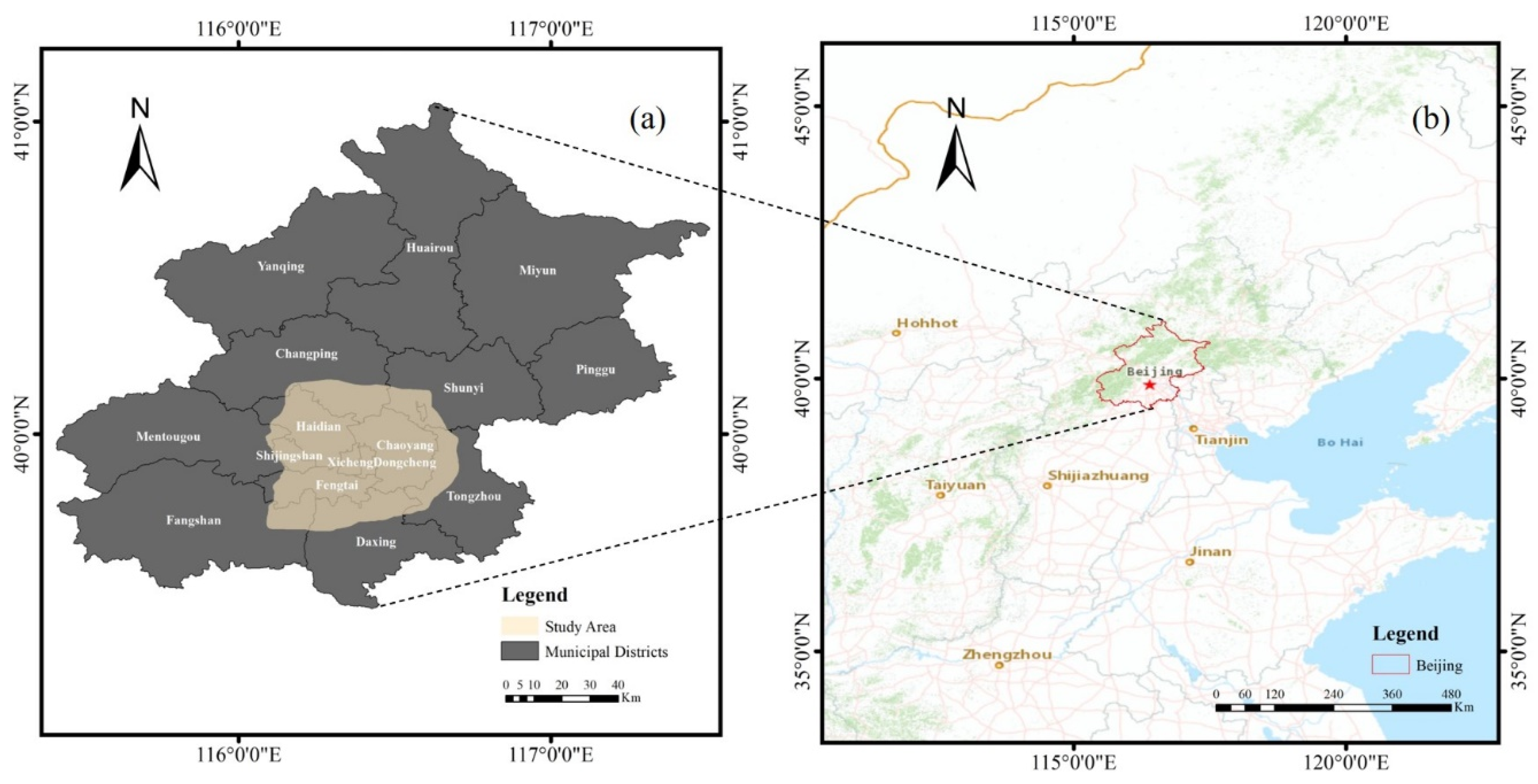

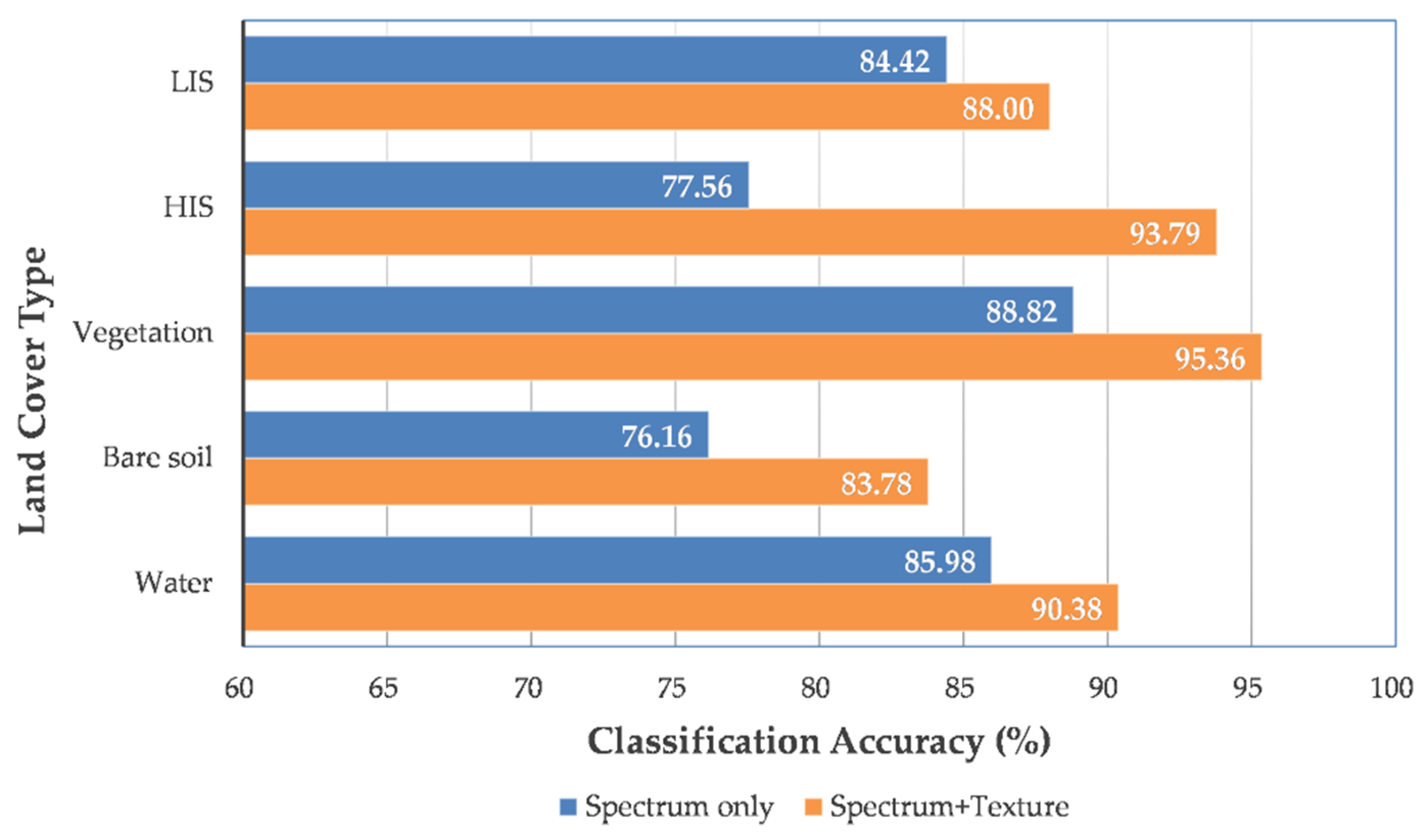
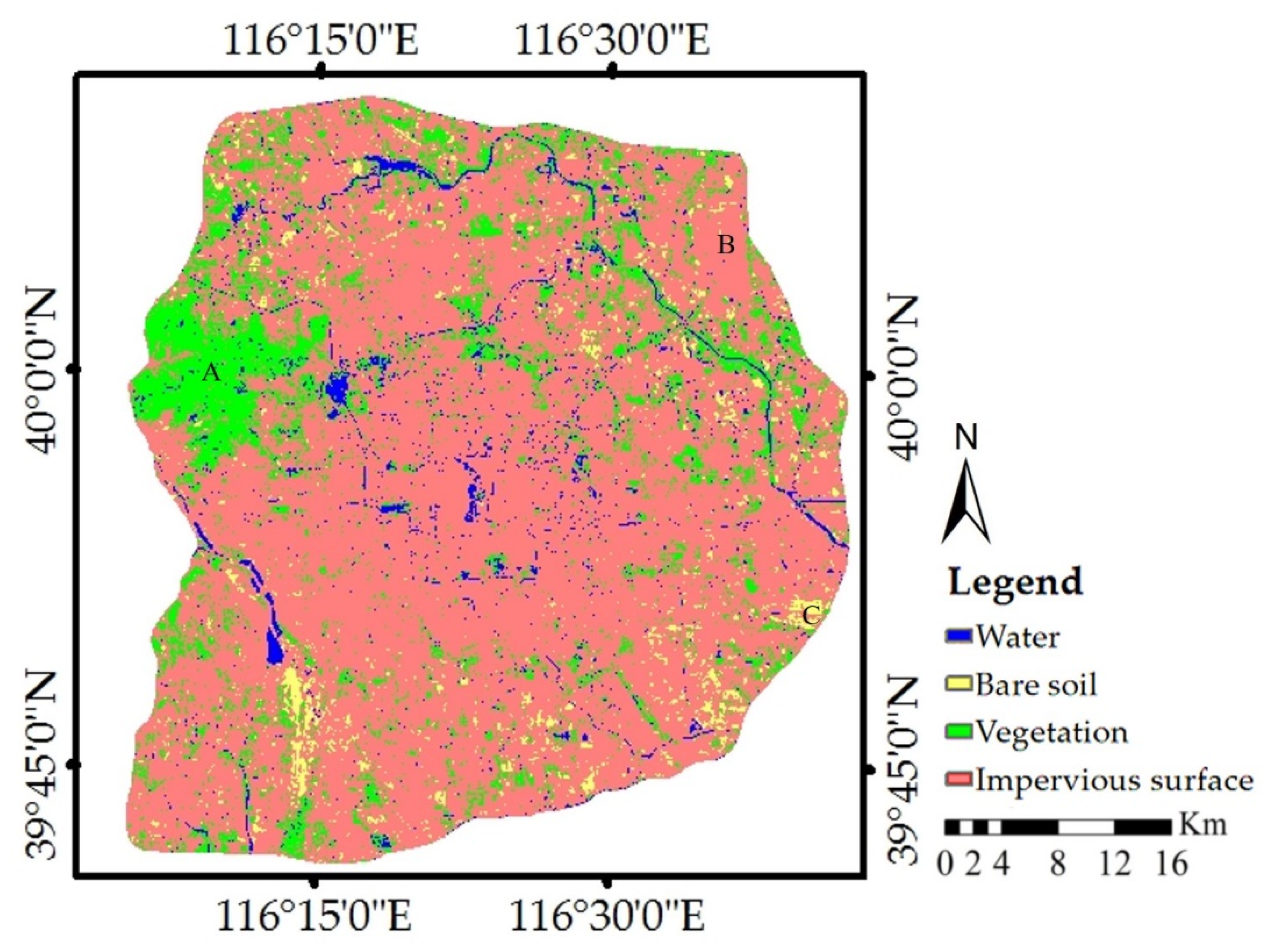

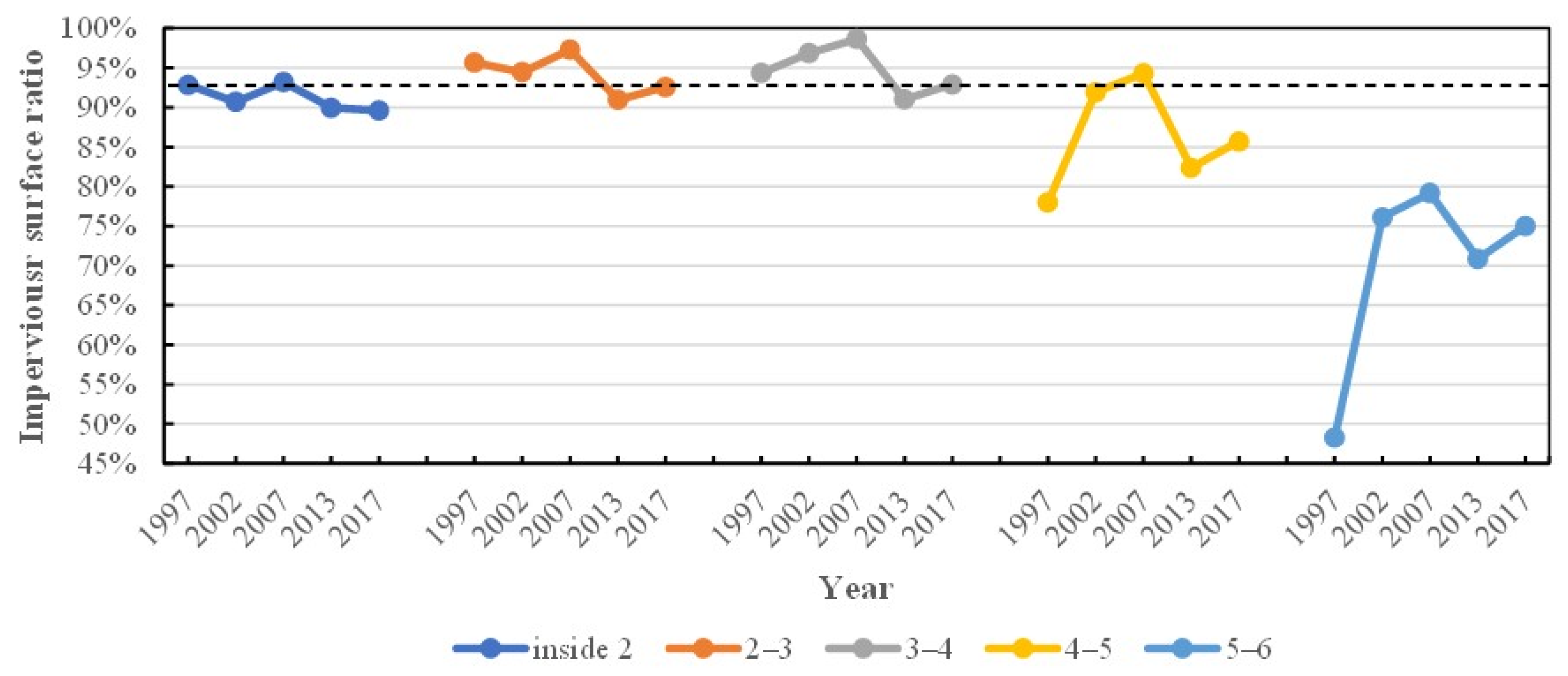
| Acquisition Date | Satellite | Sensors | Path/Row |
|---|---|---|---|
| 16 May 1997 | Landsat-5 | TM | 123/32 |
| 22 May 2002 | Landsat-7 | ETM+ | 123/32 |
| 28 May 2007 | Landsat-5 | TM | 123/32 |
| 12 May 2013 | Landsat-8 | OLI | 123/32 |
| 23 May 2017 | Landsat-8 | OLI | 123/32 |
| Type | Name | Number |
|---|---|---|
| Spectral features | Blue, Green, Red, NIR, SWIR1, SWIR2, PC1, PC2, MNF1, MNF2, MNF3 | 11 |
| Textural features | PC1_Mea, PC1_Var, PC1_Hom, PC1_Co, PC1_Dis, PC1_Ent, PC1_Sec, PC1_Cor; PC2_Mea, PC2_Var, PC2_Hom, PC2_Con, PC2_Dis, PC2_Ent, PC2_Sec, PC2_Cor | 16 |
| Regions | Date | ||||
|---|---|---|---|---|---|
| 1997 | 2002 | 2007 | 2013 | 2017 | |
| Within 2 | 58.49 | 57.13 | 58.72 | 56.68 | 56.45 |
| 2–3 | 91.81 | 90.68 | 93.40 | 87.28 | 88.87 |
| 3–4 | 134.89 | 138.51 | 141.01 | 130.13 | 132.85 |
| 4–5 | 284.51 | 335.52 | 344.13 | 300.60 | 312.85 |
| 5–6 | 772.37 | 1217.83 | 1267.03 | 1133.73 | 1199.92 |
| Total | 1342.06 | 1839.67 | 1904.28 | 1708.41 | 1790.93 |
| Regions | Period | |||
|---|---|---|---|---|
| 1997–2002 | 2002–2007 | 2007–2013 | 2013–2017 | |
| Within 2 | −0.06 | 0.07 | −0.09 | −0.01 |
| 2–3 | −0.05 | 0.12 | −0.27 | 0.07 |
| 3–4 | 0.16 | 0.11 | −0.48 | 0.12 |
| 4–5 | 2.25 | 0.38 | −1.92 | 0.54 |
| 5–6 | 19.65 | 2.17 | −5.88 | 2.92 |
| Total | 21.95 | 2.85 | −8.64 | 3.64 |
| Regions | Date | Mean | Coefficient of Variation | ||||
|---|---|---|---|---|---|---|---|
| 1997 | 2002 | 2007 | 2013 | 2017 | |||
| 2 | 92.84 | 90.68 | 93.20 | 89.96 | 89.60 | 91.26 | 1.82 |
| 2–3 | 95.64 | 94.46 | 97.29 | 90.92 | 92.57 | 94.18 | 2.66 |
| 3–4 | 94.33 | 96.86 | 98.61 | 91.00 | 92.90 | 94.74 | 3.21 |
| 4–5 | 77.95 | 91.92 | 94.28 | 82.36 | 85.71 | 86.44 | 7.78 |
| 5–6 | 48.27 | 76.11 | 79.19 | 70.86 | 75.00 | 69.89 | 17.81 |
Publisher’s Note: MDPI stays neutral with regard to jurisdictional claims in published maps and institutional affiliations. |
© 2021 by the authors. Licensee MDPI, Basel, Switzerland. This article is an open access article distributed under the terms and conditions of the Creative Commons Attribution (CC BY) license (http://creativecommons.org/licenses/by/4.0/).
Share and Cite
Dong, X.; Meng, Z.; Wang, Y.; Zhang, Y.; Sun, H.; Wang, Q. Monitoring Spatiotemporal Changes of Impervious Surfaces in Beijing City Using Random Forest Algorithm and Textural Features. Remote Sens. 2021, 13, 153. https://doi.org/10.3390/rs13010153
Dong X, Meng Z, Wang Y, Zhang Y, Sun H, Wang Q. Monitoring Spatiotemporal Changes of Impervious Surfaces in Beijing City Using Random Forest Algorithm and Textural Features. Remote Sensing. 2021; 13(1):153. https://doi.org/10.3390/rs13010153
Chicago/Turabian StyleDong, Xuegang, Zhiguo Meng, Yongzhi Wang, Yuanzhi Zhang, Haoteng Sun, and Qingshuai Wang. 2021. "Monitoring Spatiotemporal Changes of Impervious Surfaces in Beijing City Using Random Forest Algorithm and Textural Features" Remote Sensing 13, no. 1: 153. https://doi.org/10.3390/rs13010153
APA StyleDong, X., Meng, Z., Wang, Y., Zhang, Y., Sun, H., & Wang, Q. (2021). Monitoring Spatiotemporal Changes of Impervious Surfaces in Beijing City Using Random Forest Algorithm and Textural Features. Remote Sensing, 13(1), 153. https://doi.org/10.3390/rs13010153






